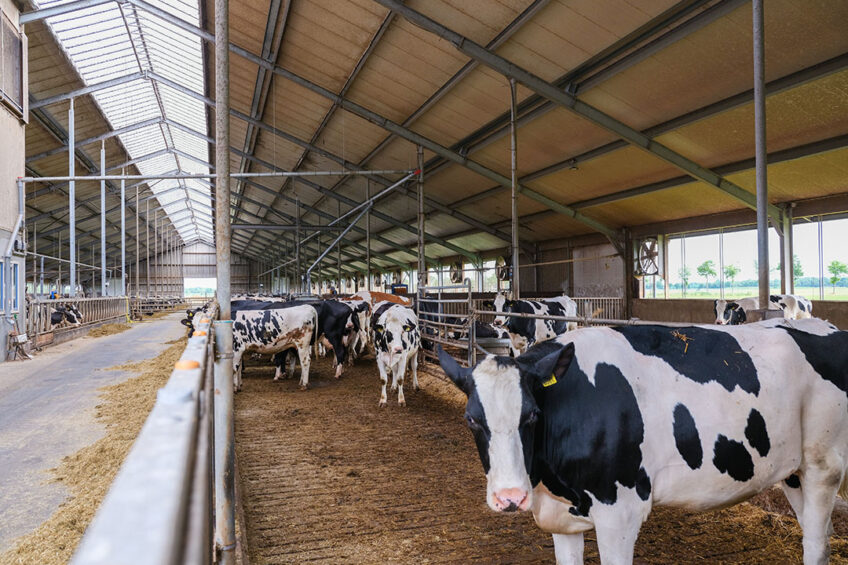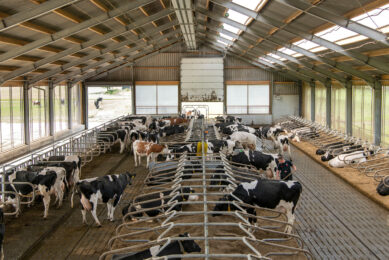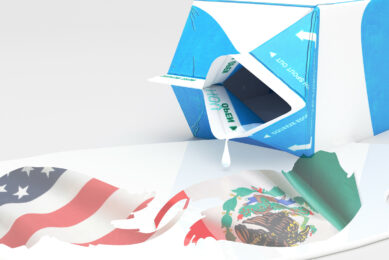Risk factors associated with bovine mastitis

Mastitis is one of the most common infectious diseases in dairy cows in the US causing persistent inflammatory reaction of the mammary gland due to physical trauma or microorganisms. On average, the total cost of mastitis is estimated to be US$147 per cow per year, which represents 11-18% of the gross margin per cow per year.
Several risk factors including pathogen, host, and environmental factors are associated with the incidence of mastitis that need to be taken into consideration in mastitis control and prevention programmes.
Pathogen factor
Contagious pathogens
Bacterial species causing bovine mastitis are classified into contagious and environmental groups based on their origin. Contagious mastitis is transmitted from cow to cow, and is caused by pathogens such as Staphylococcus aureus, Streptococcus agalactiae, and Mycoplasma bovis. Staphylococcus aureus is the main pathogen associated with clinical and sub-clinical mastitis. Streptococcus agalactiae lives in bovine gastrointestinal tract and in the environment and it is transmitted through milking machine and oral-faecal route including contaminated drinking water.
Mycoplasma spp. damage secretory tissues and induce gland and lymphatic nodule fibrosis and abscesses. Contagious pathogens live on the cow’s udder and teat skin, colonising and growing into the teat canal; therefore, reducing contact between reservoirs and uninfected cows, proper maintenance of milking equipment, post-milking teat disinfection, culling, and dry cow therapy reduce the incidence of contagious infections.
Environmental pathogens
Environmental pathogens are opportunistic agents existing in the bedding and housing of the herd. Environmental pathogens enter the teat during milking or when a cow’s natural immunity is weak, causing clinical mastitis. Environmental pathogens include E. coli, Streptococcus uberis, and Enterococcus spp.
E. coli persists in the mammary gland, invades the udder through teat, proliferates, and initiates inflammatory response in dairy cow by endotoxin found on its outer membrane known as lipopolysaccharide, causing clinical and transient mastitis. Streptococcus uberis is detected in lips, tonsils, skin, oral cavity, rumen, respiratory tract, rectum, teat orifice, teat canals, infected udders, faeces, and wounds causing recurrent clinical and sub-clinical mastitis resistant to antibiotic treatment.
Enterococcus spp., such as Enterococcus faecalis and Enterococcus faecium are present in the organic bedding material of the herd and they are resistant to several antibiotics such as lincomycin, tetracycline, kanamycin, and streptomycin, causing recurrent and persistent infection which are difficult to treat. Decreasing teat end exposure to the environmental pathogens, maintaining hygiene of udder and milking, and boosting dairy cow resistance to intra-mammary infection by antibiotic intervention and vaccination reduce environmental infections.
Host factor
Host genetics affects susceptibility or resistance to mastitis. High-producing dairy cattle such as the Holstein-Friesian breed are more susceptible to mastitis than medium-yielding breeds such as Jersey and lower-yielding breeds such as Rendena. In addition, primiparous cows are more resistant to intra-mammary infection compared with multiparous cows because of immunocompetence.
Moreover, udder structure, teat size, and teat to floor distance impact the susceptibility to the infection; therefore, dairy cows with large funnel-shaped teats or pendular-shaped udder and blind quarters after calving are more vulnerable to sub-clinical mastitis.
Age is another risk factor affecting infection occurrence, with older cows being more susceptible to infections due to wider or permanently partially open teat canal and increased permeability of mammary epithelium caused by frequent milking and previous inflammation. During the transition period, also known as the periparturient period, dairy cows are at a higher risk of acquiring mastitis due to immunosuppression related to increased oxidative stress and low antioxidant defense.
Host nutritional stress and negative energy balance during lactation due to diet deficiencies in trace elements such as selenium, iron, copper, zinc, cobalt, chromium, amino acids such as lysine, L-histidine, and vitamins A, C, E, β-carotene, and lycopene will lead to immunosuppression at cellular and humoral level and enhance susceptibility to mastitis.
Environment factor
Environmental conditions such as high stocking density, contaminated floor, wet bedding, poor ventilation, and hot and humid climate promote the growth rate of mastitis pathogens, enhance the rate of dairy cow exposure; thus, leading to higher occurrence of mastitis.
Conclusion
Mastitis leads to economic losses in dairy industry due to reduced milk production, low milk quality, and early culling. Identifying risk factors associated with mastitis is essential to prevent the disease and to develop an effective control programme. In addition, due to the development of antibiotic resistance, further research is required to find new therapeutic alternatives before commercial applications.
Join 13,000+ subscribers
Subscribe to our newsletter to stay updated about all the need-to-know content in the dairy sector, two times a week.










